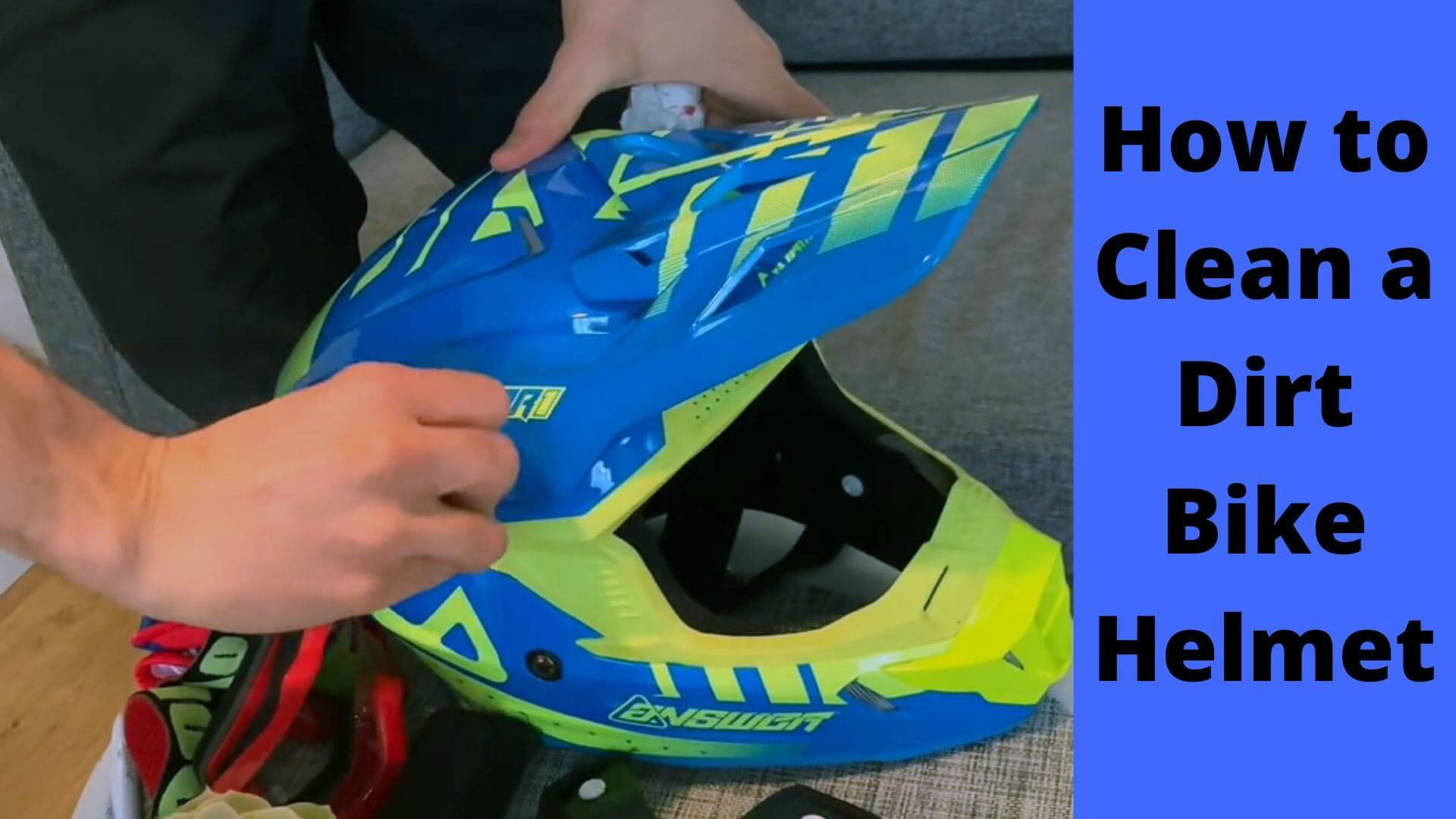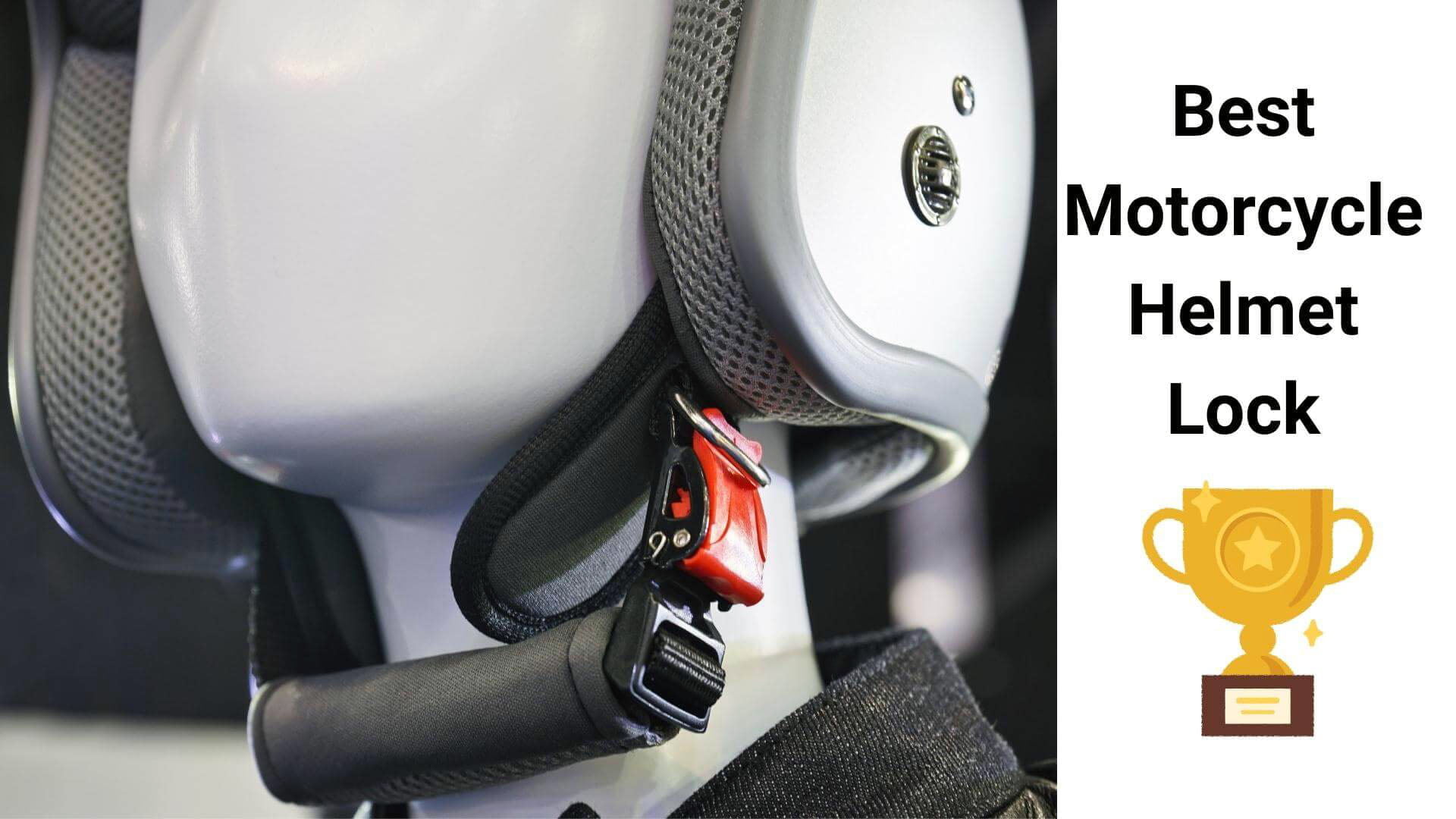How to Tint a Motorcycle Helmet Visor Easily And Safely

Motorcycle helmets are an excellent way to keep your head safe in case of an accident, but in warm weather, they can be uncomfortable and hot.
However, what about the sun’s ultraviolet rays and glare when driving? Precisely for this reason, do you need a tinted motorcycle visor?
With a tinted visor, you won't have to battle the relentless glare during long road trips under the scorching sun.
Additionally, you will be able to manage eye fatigue during daytime rides better. The best technique to make helmets more comfortable is by tinting the visor.
Before tinting your motorbike helmet’s visor, ensure that your state’s regulations permit it. There are numerous advantages to tinting your visor, such as protecting your eyes from glare and preventing accidents.
Use only high-quality materials since low-cost tint foil might cause more harm than benefit. In this post, I will cover the advantages and disadvantages of tinting a motorcycle helmet visor, how to do it, what sort of foil to use, and how to avoid improper tinting.
What is a Motorcycle Helmet Visor?
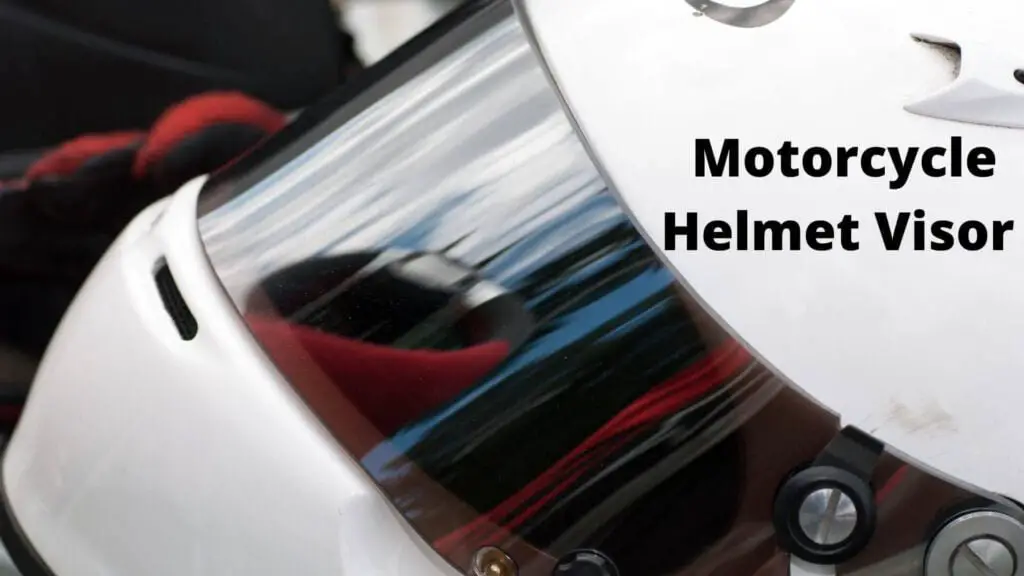
A motorcycle helmet visor is a small, transparent window covering the wearer’s eyes while riding a motorcycle. Bills can be tinted to provide different levels of darkness or brightness for the rider. Motorcycle visors are also often equipped with anti-fog and anti-scratch treatments to keep the rider’s vision clear in adverse weather conditions.
Is it Legal to Wear Tinted Motorcycle Visors?
Yes, tinted visors for motorcycles are legal. But the thing is, some states require motorcyclists to keep their tinted visors down when they are on the road.
Each country has various regulations regarding tinted motorcycle visors. Therefore it is best to confirm with the country or state where you are riding. However, the following countries and their respective laws will give you an idea:
- USA: In the United States, tinted visors are permitted. It is important to note that some states require that riders who use full-face helmets must ride with the bill closed at all times; as a result, you may be caught short if the weather changes or if you go out later than anticipated becomes dark.
- Australia: Australia requires that all visors adhere to the AS 1609 standard.
- Canada: In Canada, tinted visors are permitted.
- UK: Tinted visors are permitted in the United Kingdom, although they must have a light transmission rating of at least 50%. In addition, tinted visors are banned at night and in low-visibility conditions.
To prevent riding illegally and safely at all times, it is best to carry a clear visor so that you can swap it out if necessary.
The only disadvantage is ensuring you have storage room on the bike for a spare visor, which is fantastic if you have panniers but could be challenging if you ride a bear cycle with little accessories.
Read More: The Top 10 Motorcycle Helmets For Those Who Wear Glasses
Why Do Motorcycle Visors Need Tinting?
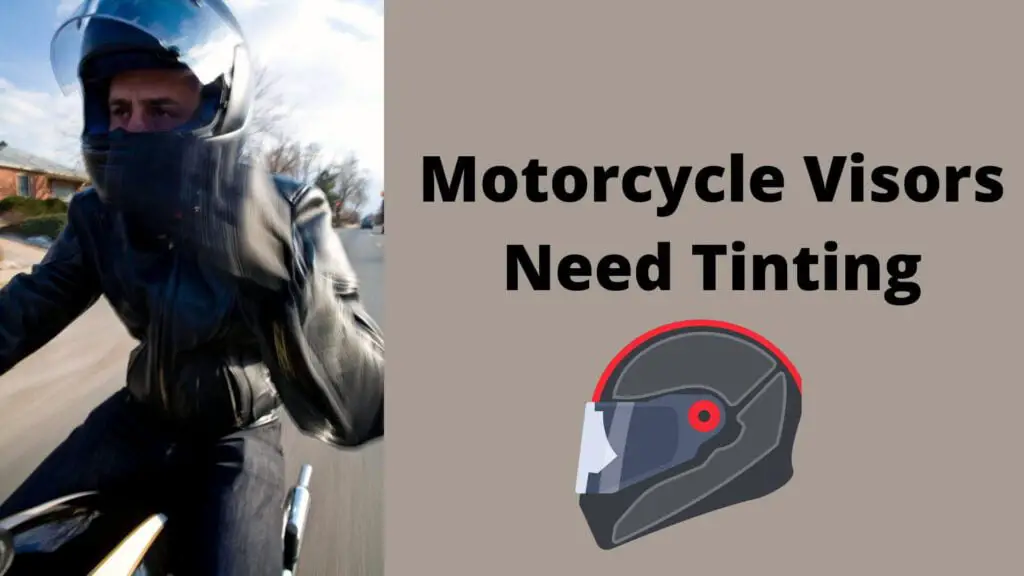
Light is required for visibility. However, excessive light might be a concern while riding for extended periods under hot, sunny conditions. Consequently, you might want to consider tinting your motorcycle’s visor. The following are the most compelling arguments for considering doing this.
Reduction in Eye Glare
On a lengthy journey, constant exposure to the sun can be exhausting and may impair focus. The glare can be extremely hazardous when driving at high speeds on congested highways. This could impair your ability to ride the motorcycle skillfully, putting you in danger, particularly with the oncoming traffic.
Even if you do not feel the need for it, a tinted motorbike visor can minimize glare and relieve eye strain. This is especially crucial if you ride in sunlight on an open road.
Protects From UV Radiation
Each day you ride your motorcycle, you will be exposed to various light sources. Light is necessary during the day because it improves vision. However, some sun rays (namely UV radiation) are hazardous and can cause discomfort over time.
The cumulative effect of UV rays will be detrimental to your eyesight. UV rays may even cause eye conditions such as AMD and cataracts. Especially on hot, bright days, tinted visors can significantly diminish the impact of UV light and help prevent retinal cell death.
Managing Eye Fatigue
Have you ever questioned why your eyes feel tired after long rides in the scorching sun? Eye tiredness frequently results in eyestrain.
This is typically caused by prolonged exposure to strong sunshine, glare, and riding that requires intense concentration. When you have to pay close attention to the road, your ciliary muscles are frequently put to the test. A tinted motorbike visor might aid in reducing eye fatigue.
Check Also: How To Choose The Right Motorcycle Glasses For Night Riding
What are the Different Types of Tinting Materials?
There are many types of tinting materials, and each has its benefits and drawbacks. The most common type of tint is the film, a transparent material placed over a motorcycle helmet’s glass or plastic lens.
Film typically comes in two colors – clear and black. The transparent film makes the motorcycle helmet look more like a clear windshield, while the black film makes the motorcycle helmet look more like a dark window.
Other types of tinting materials include:
- Heat-resistant films protect against the sun’s heat.
- Carbon filters are used to reduce air pollution.
- Reflective films are used to increase visibility at night or in low-light conditions.
When choosing a type of tint for your motorcycle helmet visor, it is essential to consider the specific needs of your ride.
For example, if you plan on using your motorcycle at night, you will want to choose a reflective film that will increase your visibility.
Read More: How to Paint a Motorcycle Helmet Like A Pro!
How to Tint a Motorcycle Helmet Visor
Tinting your motorcycle’s visor need not be a challenging task. You only require the proper equipment, materials, and instructions.
Things You’ll Require:
- Tint film
- Heat weapon
- Microfiber fabric
- Utility blade
- Edged squeegee
- Hand towels
- Soapy water
- Glass polish
How to Do It Step-by-Step
Step 1: Begin by cleaning and conditioning your visor with a cloth or microfiber cloth.
Step 2: Pour clear or tinted sealant onto a clean, dry foam applicator pad.
Step 3: Apply the sealant to one side of the visor and evenly coat both sides. Allow the glue to dry for at least 30 minutes before moving on to step 4.
Step 4: If you’re using a clear sealant, you’ll need to apply a light layer of transparent protective wax over the top of the bond. This will help protect your visor from UV rays and other elements that may cause it to wear prematurely.
Step 5: If you’re using a tinted sealant, you’ll need to apply a darker layer of tint over the top of the transparent protective wax. Be sure to evenly coat both sides of the visor with the tinted sealant.
Step 6: Allow the tinted sealant to dry for at least 30 minutes before moving on to step 7.
Step 7: You’ll need to apply a final layer of transparent protective wax to your visor. Ensure all the wax is completely dry before putting your helmet back on.
Read More: Change Visor on AGV Helmet?
What are the Pros and Cons of a Tinted Visor?
PROS:
- Reduces glare when riding in low sunlight and when the road is wet.
- Helps you see better while riding, reduces eye fatigue, and makes you more focused.
- Dark-tinted visors can also keep a significant amount of the sun’s heat out of your helmet, keeping you cooler on hot days.
- No need to bring sunglasses, as wearing glasses in certain motorbike helmets might be very uncomfortable.
- You can also combine a tinted visor with a Pinlock bill to prevent fogging.
- Some riders like the look of a tinted visor, and with so many color options, you may match your bill to your helmet and bike.
- If one exists, you can also tint your visor at home, which can be less expensive than purchasing a tinted visor from your helmet’s manufacturer.
CONS:
- At night, a tinted helmet visor is dangerous because it blocks your view and makes it hard to see. Also, it may be against the law in some countries or states to use a tinted visor at night.
- A tinted visor can be just as dangerous if the weather changes and it gets cloudy or rainy. Rain is annoying enough when your bill is clear, but it can be hard to see when your visor is tinted.
What Do You Use to Tint the Visor of Your Motorcycle Helmet?
Vinyl wraps are the most common tinting film used on motorcycle helmets. This kind of film is tough vinyl that can withstand the weather and won’t hurt your visor.
There are many different colors and styles of vinyl wrap, so you can find one that fits your personality and style. And because it’s easy to use, you don’t have to pay someone else to do it.
Are Tints For Motorcycle Helmet Visors that Make it Easier to See at Night?
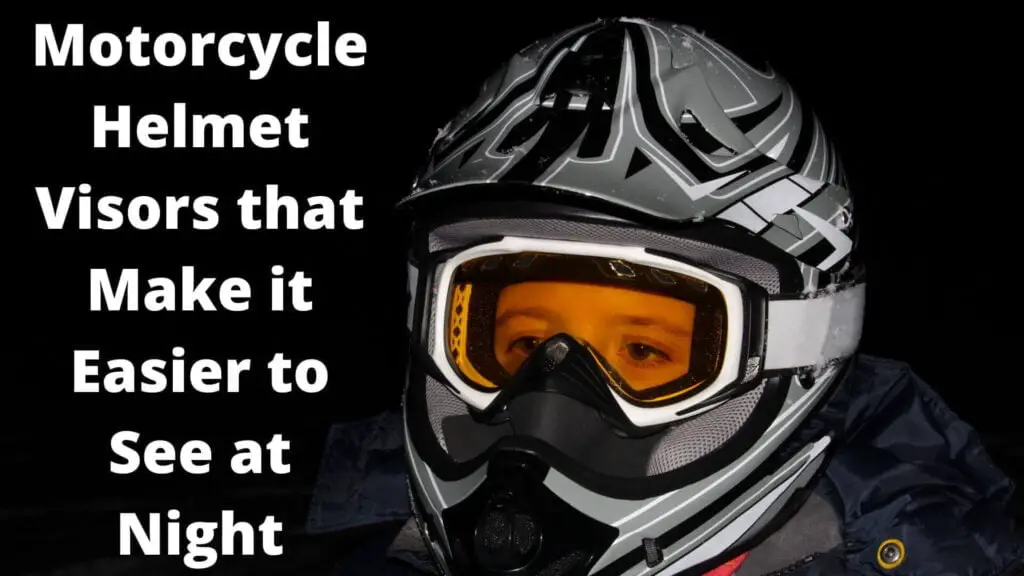
Yes, you can put some tints on a motorcycle helmet visor to help you see better at night. Most of the time, the surface of these tints is light or shiny, allowing light to get back into your eyes.
This can help you see better when there isn’t much light and make it easier to see potential road hazards. If you want a tint to help you see better at night, keep an eye out for those.
Which Type of Tint Should You Use?
Tint film comes in two main types: static cling and adhesive. Static cling is easiest to use, but it doesn’t last as long as glue. If you choose static cling, buy a high-quality product that won’t come off quickly.
The sticky tint is harder to put on, but it will last longer and be less likely to come off than static cling.
Which Tints Are Ideal For Motorcycle Visors?
The best tints for motorcycle visors are made of high-quality materials and don’t reflect much light. You also want paint that won’t change color or fade over time.
Brands like Bell, Giro, and Shoei make some of the best tints on the market. Check out their products if you want a great tint job.
How To Identify Low-Quality Helmet Visor Tint?
Knowing how to spot low-quality products when you’re looking for a tint for your motorcycle helmet visor is essential. This is because cheap dyes can change how your bill looks and how safe you are while riding.
Some ways to tell if the tint isn’t very good are:
- Tints that cost less will not be as good as tints that cost more.
- Don’t use very dark tints. These things can make it hard to see during dangerous riding.
- Before you buy any tint, make sure to read the reviews. This will give you an idea of how well the product works.
- Don’t buy tints that say they are “universal.” Most of the time, these are cheap and might not fit your visor right.
- Make sure the tint you pick is made of something that will last. This will make it last longer and less likely to fade or peel.
- If you think about these things, you should be able to find a good tint for the visor of your motorcycle helmet. By choosing a good product, you can ensure that your bill looks excellent and that you are safe while riding.
How to Take Care of Your Motorcycle Visor With Tint?
- Don’t use harsh chemicals or rough materials to clean your visor. This can hurt the tint and make it last less long.
- Use only mild soap and water to clean your visor.
- Don’t let your visor get too hot or too cold because this can also damage the tint.
- Keep your visor in a cool, dry place when you’re not using it.
- Check your visor often for damage or signs of wear and tear. If you see any problems, you should fix or replace the tint as soon as possible.
How to Remove Tinted Motorcycle Helmet Visor?

You will need a unique tool to remove a tinted motorcycle helmet visor. This tool will remove the tint without damaging the helmet.
If you want to change the tint on your motorcycle helmet visor, there are a few different ways. You can remove the tinted visor altogether, or you can remove the film protecting the underlying glass.
If you want to change the tint without obliterating the visor, you can use a household item like Windex and water to clear away the film.
Once the film is removed, you can apply a new layer of tint using any of several products available at your local hardware store.
1. Remove the helmet from the rider’s head.
Some riders remove their helmets when they are not on the motorcycle. This is usually done while the bike is still parked. Some riders remove their helmets while riding but do not want to take them off while driving. There are a few ways to tint a motorcycle helmet visor to give context to the rider’s face.
2. Unfasten the helmet straps
It is essential to take care when tinting motorcycle helmet visors.
- First, it is necessary to unfasten the helmet straps.
- Second, the tint must be applied in a specific order so that it will not affect the visibility of the rider’s eyesight. To do this, start by applying a light layer of tint over the front and back of the lens. Then, use a brush or fingertips to apply a thicker layer close to your eyes.
- Finally, use a fine-tip applicator to add a final layer on top.
3. Gently remove the tinted motorcycle helmet visor.
If the tinted motorcycle helmet visor is scratched or damaged, it may need to be gently removed to restore the original color.
Use a cloth, soft brush, or fingernail to remove dirt, dust, or debris. If any adhesive has been used on the helmet visor, gently scrape it off with a knife before removing it. Be sure not to damage the underlying sealant; use a light touch only.
Read More: How Do You Take Care Of a Motorcycle Helmet?
(FAQs) About How to Tint a Motorcycle Helmet Visor
Are there any problems with tinting the visors on a motorcycle?
Tinting your motorcycle’s visor is a great way to make daytime riding more comfortable and look cool, but there’s a catch.
First, you can only use a visor with tint during the day. When you’re driving at night, this can be a big problem. If you think your ride will go late into the night, you should always bring a spare clear visor.
Second, the weather could change suddenly in the summer, making it hard to see.
Third, some tunnels may be longer than you expect and have lousy lighting.
Does tinting a motorcycle visor make your insurance void?
You may have heard on online motorcycle forums that tinted visors could make your insurance void in a motorcycle accident.
You have to wear a DOT-approved helmet, which means the visor has to be approved. But to be safe, you should check the laws in your state and ask an insurance company. You might also want to know if it’s possible to paint a motorcycle helmet.
Can I use a pin-lock on a visor with tint?
The pin-lock system is an excellent way to double-glaze the visor so it doesn’t fog up. The airtight pocket between the bill and the pin-lock makes an extra layer of insulation, which makes it harder for the fog to form.
Still, you can use a pin-lock with a tinted visor you made yourself as long as the bill is pin lock-ready. A tinted pin-lock with a clear visor may let some sun glare in around the edges. A clear pinlock would be a good backup plan when the weather changes without warning.
Can I tint a motorcycle’s visor with a spray?
Tint sprays are another way to change the color of something. The way to do it is pretty straightforward and might only take a few minutes. After cleaning the visor, you must spray the tint on it and let it dry. But this isn’t as useful, popular, or reliable as a tint film.
Which type of tint film is the best?
Polycarbonate is the most common material for tint film because it is very good at absorbing UV rays, which helps protect your eyes from the hot sun.
Final Thought
Do you want to protect your eyes better and enjoy your rides during the day more? The visor can be tinted to do this. Our clear instructions should help you finish the job quickly and satisfactorily.
But it would be a bad idea to ride a motorcycle at night with a tinted visor. It would help if you considered getting a clear pinlock or bill for riding at night and when the weather changes.

Hey, I’m Hrithik Hossain. I am the head of helmethacks.com, which specializes in safety helmets. I am looking to connect with anyone interested in purchasing a helmet or who has any questions about different types of helmets. I have over 8 years of experience as a helmet expert, and I can’t wait to help you find the perfect helmet for you. I can help you with any questions regarding helmets, from the best brands to fitting, style, and more! I really enjoy keeping people safe by ensuring they have the best protection possible.



